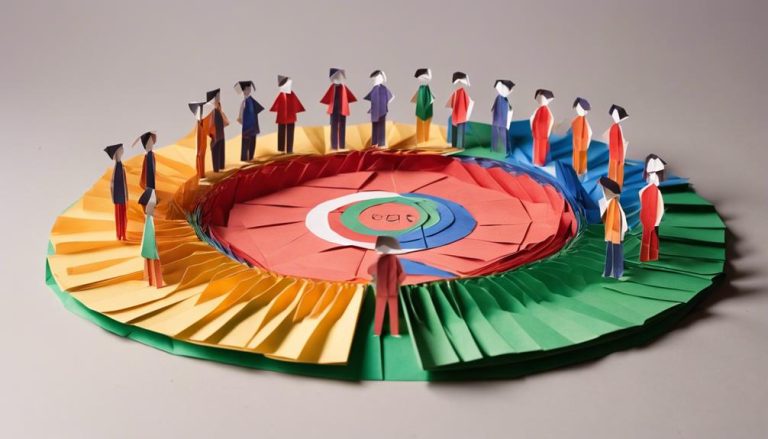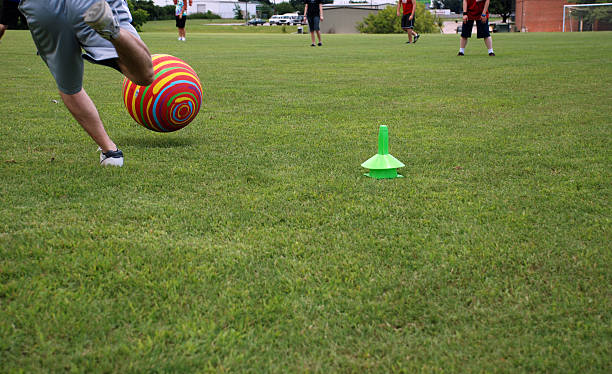General Rules of Gridiron Football
To comprehend gridiron football, you aim to advance the ball across the opponent's goal line, blending power, precision, and agility for success. Focus on offensive and defensive tactics, essential for victory. The field's length and width play a significant role, along with scoring systems like touchdowns, field goals, and safeties. Mastering game mechanics, from downs to play clock, is vital. Develop strong offensive strategies such as passing techniques and running game tactics. Defensive strategies like zone coverage and blitz packages help control the game. Reveal more about penalties, time management, player positions, and the game format for deeper insight into this dynamic sport.
Basic Objective
In Gridiron Football, the fundamental objective is to advance the ball across the opponent's goal line to score points. This vital goal drives the entire game strategy, shaping every play and decision on the field. To achieve this objective, teams employ a variety of offensive and defensive tactics aimed at outsmarting their opponents.
Game strategy in Gridiron Football involves a delicate balance of power, precision, and agility. Offensively, teams strategize on how to move the ball down the field effectively, whether through running plays that rely on brute force or passing plays that require finesse and accuracy. Defensively, the focus shifts to preventing the opposing team from reaching their goal line by disrupting plays, forcing turnovers, and ultimately regaining possession of the ball.
Understanding the basic objective of advancing the ball to score points is essential for success in Gridiron Football. By mastering game strategy, teams can outmaneuver their opponents and secure victory on the gridiron.
Field Layout
As you study the field layout in gridiron football, you will discover key points about the field dimensions and the end zones. Understanding the specific measurements of the field and the scoring areas will enhance your knowledge of the game. These points are fundamental in grasping the strategic elements of each play on the gridiron.
Field Dimensions
When discussing the field dimensions of gridiron football, it's important to understand the specific measurements and layout that define the playing surface. Player safety and equipment requirements are closely tied to field dimensions. A standard football field is 120 yards (360 feet) long and 53.3 yards (160 feet) wide, with end zones adding an additional 10 yards each. The hash marks on the field help regulate where the ball is placed between plays. Field maintenance and turf conditions are essential for ensuring a safe and fair game. Properly maintaining the turf not only enhances player performance but also reduces the risk of injuries. Understanding the dimensions of the field is critical for players, coaches, and officials to guarantee the game runs smoothly and safely.
End Zones
Within the confines of a football field, the end zones serve as important areas that play a significant role in the field layout. These areas are where the magic happens, where touchdowns are scored, and emotions run high. End zone celebrations, while exciting, should always embody sportsmanship to respect the game and opponents. End zone design is essential, with safety considerations being a top priority. The layout must guarantee that players have enough space to make plays without compromising their well-being. Proper markings and padding are essential in creating a safe environment for all athletes. Remember, while the end zone is a place for jubilation, it's also a space where respect for the game and fellow players should always shine through.
Scoring System
The scoring system in gridiron football is designed to assign points based on various actions and outcomes during a game. Points can be earned through touchdowns, field goals, extra points, two-point conversions, and safeties. A touchdown is worth six points and is scored when a player crosses the opponent's goal line with the ball or catches it in the end zone. After a touchdown, the scoring team has the option to kick an extra point (worth one point) by kicking the ball through the uprights, or attempt a two-point conversion (worth two points) by running or passing the ball into the end zone again.
Field goals are worth three points and are scored by kicking the ball through the opponent's goal posts. A safety, which is a rare play, is worth two points and occurs when an offensive player is tackled in their own end zone. Understanding the scoring system is essential for both players and fans, as it adds depth and excitement to the game.
Down and Distance
As you progress through the game of gridiron football, understanding the concept of 'Down and Distance' becomes essential for both players and fans alike. The 'down' refers to the number of chances, or plays, a team has to advance the ball, usually having four downs to move the ball 10 yards towards the opponent's end zone. The 'distance' is the yards a team needs to cover to achieve a new set of downs. This information is vital as it determines the team's strategy and play-calling.
The play clock is the designated time a team has to snap the ball before incurring a penalty. It typically lasts around 40 seconds, and failure to snap the ball within this timeframe results in a delay of game penalty. The line of scrimmage is an imaginary line where the ball is placed at the start of each play. It signifies the point on the field where the play begins and where players must line up before the ball is snapped.
Understanding these fundamental concepts of down and distance, along with the play clock and line of scrimmage, is essential for a successful gridiron football game.
Offensive Plays
Let's break down the key points of offensive plays in gridiron football: passing strategies, running game tactics, and blocking techniques. These elements are essential for a successful offensive drive, helping teams execute plays effectively and gain yardage. Understanding these points will give you insight into the strategic decisions made by coaches and players on the field.
Passing Strategies
When considering offensive plays in gridiron football, passing strategies play an essential role in moving the ball down the field efficiently and effectively. Quarterback accuracy and receiver routes are vital elements in successful passing strategies. Play action passes help in deceiving the defense, creating openings for receivers downfield. Screen plays are effective for short gains and can catch the defense off guard, leading to significant yardage. To excel in passing, timing between the quarterback and receivers is key, ensuring seamless execution of plays. By varying passing strategies, you can keep the defense guessing and gain an advantage on the field. Implementing a mix of these tactics can elevate your team's offensive performance and keep the opposition on their toes.
Running Game Tactics
Running game tactics in gridiron football are essential for gaining yards on the ground and keeping the defense off balance. When it comes to offensive plays, incorporating play action and option runs can be highly effective strategies. Play action involves deceiving the defense into believing a pass is being thrown, only to hand the ball off to a running back for a surprise run. On the other hand, option runs give the quarterback the choice to either keep the ball and run themselves or pitch it to a teammate. This dual-threat forces the defense to make quick decisions, creating opportunities for big gains. Utilizing these tactics effectively can lead to a more dynamic and successful running game.
| Play Type | Description |
|---|---|
| Play Action | Deceive defense with fake pass, hand off to runner. |
| Option Runs | QB decides to run or pitch based on defense's movement. |
Blocking Techniques
To enhance the effectiveness of offensive plays in gridiron football, mastering proper blocking techniques is imperative for creating openings and protecting the quarterback. When it comes to blocking, paying attention to details like block timing and hand placement is essential. Here are some key points to take into account:
- Block Timing: Timing is everything in football; a well-timed block can make all the difference in creating space for the ball carrier.
- Hand Placement: Proper hand placement can help you control your opponent and steer them away from the intended path.
- Angle Leverage: Understanding the angles of your blocks can give you the leverage needed to overpower the defender effectively.
- Communication Cues: Clear communication among teammates is crucial to make sure everyone is on the same page and executing blocks efficiently.
Mastering these techniques can elevate your game and contribute to the success of the offensive plays.
Defensive Strategies
In Gridiron Football, defensive strategies play an essential role in stopping the opposing team's offense and securing victory. Two key defensive strategies commonly used are zone coverage and blitz packages.
Zone coverage involves defenders covering specific areas of the field rather than individual players. This strategy allows defenders to react to plays as they develop, making it harder for the offense to find open receivers. It requires excellent communication and coordination among defenders to make sure all zones are covered effectively.
On the other hand, blitz packages involve sending additional defenders to rush the quarterback, putting pressure on the offense and disrupting their passing game. By overwhelming the offensive line with blitzing players, teams aim to force quick decisions from the quarterback, increasing the chances of sacks or incomplete passes.
These defensive strategies are vital for controlling the flow of the game, dictating the pace, and ultimately, securing victories. Understanding when and how to deploy these strategies effectively can give your team a significant advantage on the gridiron.
Penalty Enforcement
When it comes to penalty enforcement in gridiron football, understanding the referee signals and the yardage consequences for infractions are vital. These points are fundamental for players and fans alike to grasp, as they directly impact the flow and outcome of the game. By being aware of the penalties and their repercussions, you can better comprehend the dynamics of the match and appreciate the strategic decisions made by teams.
Referee Signals Penalties
Gestures made by football referees signal penalties during gameplay, important for enforcing rules and maintaining fairness on the field. When a referee signals a penalty, it's vital to understand the infraction. Here are some key points to contemplate:
- Referee Communication: The way referees communicate penalties can impact player reactions and game momentum.
- Player Reactions: Players' responses to penalties can influence team dynamics and future gameplay strategies.
- Penalty Review: Referees may review penalties to verify, affecting the flow and outcome of the game.
- Coach Challenges: Coaches have the opportunity to challenge certain penalties, adding a strategic element to penalty enforcement.
Understanding these aspects of referee signals enhances your grasp of penalty enforcement dynamics.
Yardage Consequences for Infractions
Understanding the yardage consequences for infractions in gridiron football is key to comprehending how penalties impact gameplay dynamics. Penalty consequences play a significant role in shaping the flow of the game. Depending on the severity of the infraction, teams can either gain or lose yardage. For instance, a holding penalty can cost a team 10 yards, pushing them back and making it harder to advance towards the end zone. On the other hand, a defensive pass interference penalty can result in a substantial yardage gain for the offense, bringing them closer to scoring. Infraction yardage directly influences field position, possession changes, and overall strategy, making it essential for players and fans to grasp the implications of each penalty.
Time Management
To effectively manage time in gridiron football, players must prioritize tasks and make quick decisions on the field. Clock management is vital in the game, especially during the hurry-up offense, where every second counts. Utilizing timeouts strategically can provide teams with the opportunity to regroup, plan their next moves, and stop the clock when needed. The two-minute drill is an intense period where teams must efficiently move the ball down the field to score before time runs out, requiring precision and composure under pressure.
- Time is Your Ally: Embrace the urgency of the clock to outmaneuver your opponents.
- Strategic Timeouts: Use timeouts wisely to gain an advantage and control the pace of the game.
- Master the Two-Minute Drill: Hone your skills to execute flawlessly in high-pressure situations.
- Clock Awareness: Stay vigilant of the time remaining to make split-second decisions that could determine the outcome of the game.
Player Positions
Embracing the urgency of the clock and mastering time management on the field, players must understand the various player positions that define the strategic dynamics of gridiron football. At the heart of the team is the quarterback, responsible for leading the offense, making critical decisions, and executing plays with precision. Understanding receiver routes is important for both quarterbacks and wide receivers, as they must be in sync to connect for successful plays.
On the defensive side, players must be well-versed in the various defensive schemes employed by their team. This includes understanding coverage assignments, pass rushing techniques, and run-stopping strategies. Special teams also play an important role in the game, with players contributing to kick returns, punts, and field goals.
Mastering these player positions is essential for success on the gridiron. Whether you're studying the quarterback responsibilities, perfecting receiver routes, learning defensive schemes, or making special teams contributions, each position is a key piece of the intricate puzzle that is gridiron football.
Game Format
The game format in gridiron football intricately weaves together rules, strategies, and execution to create a dynamic and competitive playing field. To fully grasp the essence of the game format, explore the following key aspects:
- Quarterback Responsibilities: The quarterback stands as the leader on the field, responsible for making split-second decisions, reading the defense, and executing plays effectively. The pressure on them is immense, requiring both mental acuity and physical skills to command the game.
- Defense Formations: Defensive strategies play an essential role in the game format, with teams utilizing various formations to counter the opponent's offense. From the 3-4 to the nickel defense, each formation aims to stifle the opposing team's progress and create turnovers.
- Special Teams Plays: Special teams are often the unsung heroes of gridiron football, contributing important points and field positions through plays like kickoffs, punts, and field goals. These plays demand precision and coordination to secure favorable outcomes.
- Clock Management: Time is a precious commodity in football, and effective clock management can be the difference between victory and defeat. Teams strategically use timeouts, play calls, and clock stoppages to control the tempo of the game and secure a win.
Frequently Asked Questions
Can Players Wear Any Type of Cleats on the Field?
You can't just choose any cleats for the field. Cleat regulations in football are strict, and players must follow specific guidelines for footwear choices to guarantee safety and performance. Make sure to check before stepping out.
Are There Any Restrictions on the Type of Gloves Players Can Wear?
When it comes to the types of gloves you can wear on the field, there are usually no restrictions. However, some leagues or teams may have brand restrictions, so it's crucial to check before gearing up.
How Often Are Footballs Checked for Inflation During a Game?
During a game, footballs are inspected for inflation approximately every quarter. These inspections guarantee fair play and prevent any advantage from altering the ball's pressure. Proper inflation levels impact gameplay by maintaining consistency and accuracy.
Can Players Switch Positions During a Game?
During a game, players can switch positions based on tactical substitutions and in-game adjustments. Position flexibility is key, allowing versatile players to adapt and contribute effectively in various roles on the field.
Are There Any Specific Rules Regarding Player Celebrations After Scoring a Touchdown?
When scoring a touchdown, remember to keep celebrations respectful. Celebratory dances and end zone celebrations are fun, but avoid taunting opponents. Enjoy your touchdown celebrations, but always play with sportsmanship in mind.






